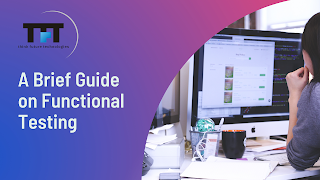A Brief Guide on Functional Testing
Modern businesses are swiftly using agile methods and DevOps to deliver faster and high-quality releases. DevOps methodology enables quicker releases through constant integration, continuous release of software and continuous testing. It aids businesses to create the highest quality and fully functional software with less time by delivering more rapid and reliable releases.
What is functional testing?
Testing for functionality in the software industry is a black-box type of software testing. The primary goal of this type of testing is to test the capabilities of an application in relation to business needs by providing inputs, and then confirming the results.
Methods for functional testing
- Testing units:
It's the first stage in the process of testing software in which developers try to test the smallest elements of the software isolation to test its capabilities.
- Component testing:
In this type of software testing, software components are tested on their own without interfacing them with other components.
- Smoke testing:
This kind of test is also known as a test for verification of the build, and is used to assess the reliability that the program is running.
- Sanity testing:
In this method of testing software testers conduct simple tests on the software.
- Integration Testing:
In this type of software testing different software modules are tested together to verify their functionality.
- Regression testing:
In this testing process this software test is conducted to confirm that recent code modifications or new functionalities do not alter the functionality of the application.
- System Testing:
In this kind of test the quality assurance group tests the software to find out the way that various components interact. This makes sure that the software functions correctly.
Why should businesses use Functional tests?
- Helps to validate the functionality and proper working of application/software/product.
- It aids in improving the quality of software.
- Aids in confirming the functionality of software based on Software Requirements Specification (SRS) and ensures that the system is operating according to the user's specifications.
- Allows you to test specific errors and other functions that are important to the program.
- Allows you to create fully functional software that is free of defects to provide a fantastic CX.
How to do Functional testing?
- Find out the testing requirements:
In the first stage of functional testing; testers must be able to fully understand the business needs and then take a position on the testing requirements in depth.
- Create a test plan
The next step is to prepare an exam plan. The test plan must be clear about the goal that the examination will accomplish, the test method and testing methods, among others.
- Write test cases:
It is one of the most crucial asp[ect of functional testing where testers design test scenarios.
- Create input data using the specifications of the function:
In order to evaluate the capabilities of an application, testers must create data, and then utilise it as input.
- Perform the test case:
It is an important test, in which testers examine the actual results with the anticipated results.
- Log defects:
In the final step test, the testers record the variances between expected and actual outcomes; and then record the variations or problems so that teams are aware of the similarity.
If you’re looking for one of the best Software Testing Outsourcing Companies for functional testing, then TFT is the QA outsourcing partner for you. With our team of expert Functional Testers.




Comments
Post a Comment